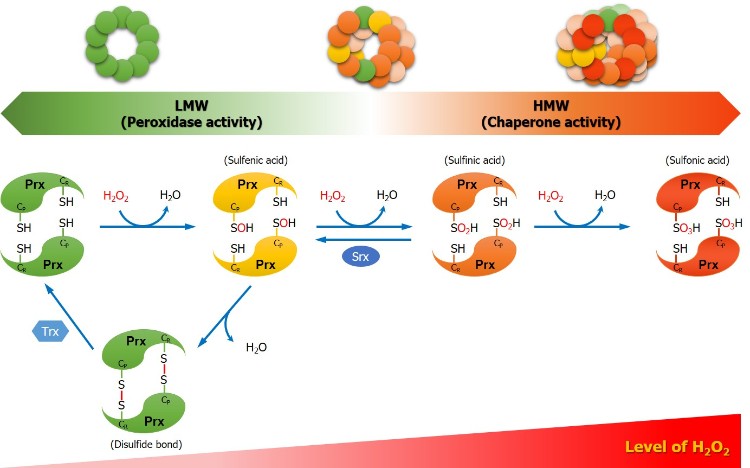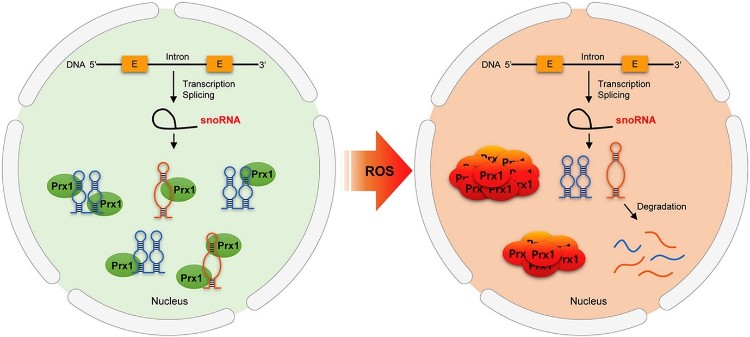Professor & Research

- Professor & Research
- Research activities(Type)
Research activities(Type)
1. Reactive oxygen species (ROS) are by-products of oxygen produced during metabolic processes and are produced by various factors, both intracellular and extracellular. Increased ROS in cells act as oxidative stress, leading to damage, modification and aggregation of proteins as well as nucleic acids, resulting in structural and functional changes, nonspecific interactions, and aggregates. The recovery or proper removal of the oxidized/modified proteins to their native form is important for maintaining the normal function of the cells. If these proteins are not removed and accumulate abnormally, their cytotoxicity cause various human diseases such as cancer, metabolic diseases, aging and neurodegenerative diseases. Therefore, maintaining intracellular redox-homeostasis is very important. Peroxiredoxin (Prx), an antioxidant defense system, has a chaperone function that protects unfolded proteins from stress as well as a peroxidase function that converts hydrogen peroxide (H2O2) into water. Both functions of Prxs are precisely regulated with structural changes depending on the concentration of H2O2.

Figure 1. Catalytic cycle of typical 2-Cys Prxs (Antioxidants 2019, 8, 169)
2. Prx1 in the Prx family functions as an RNA-binding protein (RBP). Among the comprehensive RBP-RNA interaction studies, Prx1 was identified as an RBP candidate protein in mRNA interactome analysis using HeLa cells, HEK293 cells, and embryonic stem cells. Through sequencing and validation studies to analyze target RNAs of Prx1, they were associated with a variety of RNA species, and in particular with non-coding RNAs, small nucleolar RNAs (snoRNAs), to regulate the expression of these snoRNAs at post-transcriptional levels. In addition, the redox state of Prx1 regulates its activity as a snoRNA-binding protein.

Figure 2. Regulation of Prx1-associated snoRNAs (Free. Radic. Biol. Med. 2019, 141:1-9)
1. Study on the regulation of disease-related factors of redox-proteins: We are identifying the importance of redox-homeostasis regulation in disease through studies on the regulation of ROS-mediated signaling pathways and protein stability of oxidized/modified proteins by redox-proteins.
2. Peroxiredoxin-RNA interaction: In the RNA world, we have studied the diversity of Prx function through the identification of redox-regulatory mechanisms depending on the target RNA species and the intracellular environment that is changed by various stresses.
3. Redox regulation of chemoresistance: Identification of regulatory factors that contribute to the acquisition of anticancer drug resistance in cancer cells and identification of regulatory mechanisms of intracellular redox status altered by acquired chemoresistance.
- Study on redox regulation by conducting SILAC (Stable Isotope labeling with Amino acid in Cell culture) to quantitatively analyze/identify the protein biomarkers.
- Establishment of SILAC cell lines: To date, our laboratory has established various SILAC cell lines such as colorectal cancer cell lines (4 types), breast cancer cell lines (2 types), hepatocellular carcinoma cell lines (6 types), pancreatic cancer cell lines (2 types), adipocytes and skin fibroblasts. In addition, we continue to have SILAC cell lines.
4. Biologics development: Protein biologics are drugs produced in large quantities in E. coli, yeasts, animal cells, etc. through gene recombination for therapeutic proteins that are difficult to isolate in large quantities in vivo. These include insulin, growth hormone, interferon, and various kinds of antibodies, which are commercialized and widely used in various diseases. In recent years, research has been actively conducted to develop a therapeutic protein drugs by recombining not only monomers but also a combination of two proteins (heterodimers) and more. A new research project in our laboratory is constructing new and modified monomers, heterodimers, and more fusion proteins using flexible linker to produce the candidates for protein biologics in various forms. These are large-scale produced by optimizing the expression and purification in E. coli, and their efficacy is verified. We are expanding and focusing on the development of protein pharmaceuticals that can be used in human diseases.
Our laboratory focuses mainly on: 1) understanding the regulatory mechanisms of disease-related factors centered on redox-proteins based on cell lines, animal models, and clinical tissues; and 2) developing systems to improve biologics.

- Name Kim, Eun-Kyung
- Major
- Field of Research
- Position

- Name Kim, Yosup
- Major
- Field of Research
- Position

- Name Kim, Dongwoo
- Major
- Field of Research
- Position

- Name Song, Min-Jeong
- Major
- Field of Research
- Position
